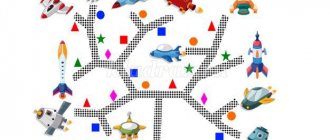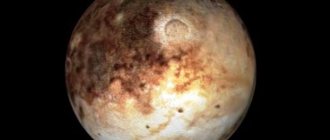Detailed description of the quest
With this quest you can easily entertain children at any holiday, children's party, on vacation and arrange a real search for a surprise at home, in an apartment or in a country house. This quest is an excellent opportunity to give children an unforgettable space adventure!
♦ Age category of the participant: from 6 to 10 years. ♦ Target audience: the quest is universal, for both boys and girls. ♦ Time to complete the quest: up to 40 minutes. ♦ Purpose of the quest: the main goal of the quest about space is to find a gift (surprise). After completing all space-themed tasks, the participant(s) will find the main cache in which the quest organizer knowingly hid the prepared gift (surprise). The quest is perfect for a child's birthday, children's party, or as entertainment for children at home, in an apartment or in any other room, giving a gift on the day of any celebration or holiday. Or, if you just decided to surprise the children during a home holiday, in which participants will be able to find answers to questions about space and find a cherished gift or surprise. ♦ Venue: quest for premises - in a house, in an apartment, in a room in which there are hiding places for this quest. ♦ Number of participants: the space quest is intended for both 1 person (gift recipient) and a group of children. ◊ single passage - the quest is solved by one participant. ◊ group passage - several participants jointly solve all the tasks and jointly find the main gift. ♦ Tasks: the “space adventure” quest includes 10 cards with tasks, designed in the style of space (planets, aliens, rockets, etc.). Tasks in the quest can be swapped and hidden in any order. ♦ Quest genre: home quest with a search for a gift in the room. ♦ Hiding places in the quest: ◊ Sofa ◊ Battery ◊ Window ◊ Stove ◊ Table ◊ Lamp ◊ Blanket ◊ Kettle ◊ Magazine ◊ In the closet If you want to conduct this quest on the street, nature or any other open area, then our website provides an Outdoor children's quest about space with a search for a gift “Space Adventure” (from 6 to 10 years old) ♦ Necessary props: pencil or pen for filling out answers. ♦ The finished quest kit includes three PDF files : 1 . The file “Instructions for the quest” contains a detailed list of necessary actions to prepare the quest for implementation. 2 . The “Quest” file contains all the cards with tasks that the participant will need to solve. 3. The “Quest with answers” file contains the entire list of tasks with detailed answers. These files will need to be printed on a black and white or color printer. ♦ Other quests on the site: ⇒ Quests up to 10 years old ⇒ Quests up to 16 years old ⇒ Quests from 18 years old
Quest plot
The plot of the quest is based on a fictional story that one day a spaceship fell to Earth. Where he came from and where he then disappeared is unknown. But at the landing site, traces were found of a mysterious message that said: “Do you want to unravel our path? You’ll have to play a little. Who are we and where do you come from? You have to find out And fly into space with the help of knowledge.” "
◊ Beginning of the quest: We recommend starting the space quest for children with the child (children) finding an envelope that was left by space inhabitants. Opening the envelope, a letter will be found in it. ◊ Letter text: “
Hello, we are space inhabitants of the Cosmica galaxy. We are the keepers of universal knowledge about space. Only a select few can get to know us and learn our secrets. Only those who solve all our tasks will be worthy of receiving universal knowledge and a cosmic gift.” Along with this message, the children will also find the first simple task, after solving which the quest with the search for the main gift will begin.
All tasks are thought out in such a way that, at the request of the quest organizer, any cards can be removed or their sequence can be changed. This opportunity will allow the organizer to construct his ideal quest using suitable hiding places.
Quest “Space Travel”
Quest “Space Travel”
(grades 2-3)
Target:
Systematize, generalize and supplement children's knowledge about space.
Tasks:
• Systematize children's ideas about the Universe, the Solar system and its planets
• development of children's cognitive and intellectual abilities, their creative potential;
• fostering a sense of pride in the achievements of domestic scientists and cosmonauts;
• fostering a caring attitude towards what is on our planet;
• development of communication skills, friendly relationships, group work.
Equipment:
- Computer;
- Pencils, felt-tip pens;
- Puzzle sheets;
- Sheets with cut pieces (puzzle)
- Sheets for the game "Find the differences"
Progress of the game:
The game begins with the song “Grass near the House” by the group “Zemlyane”
- Dear Guys! Our travel game today is dedicated to April 12th. What holiday is celebrated on this day?
— World Aviation and Space Day.
- We will now divide into 3 teams using a draw and go on a space journey. The guys pull out pieces of paper with drawn pictures: a star, a rocket, a comet and sit down at 3 tables (crew) with the names “Rocket”, “Star” and “Comet” (you can come up with other names). Each team needs to choose a crew captain.
— At each station you will need to complete tasks. For all correct answers or solutions you will receive points. Whose crew scores the most points, the faster they will be back on planet Earth. So, let's go on a journey.
1 station "Mysterious"
At this station, each crew will need to solve riddles. I will ask the riddles one by one. If the crew cannot answer, then the other crew has the opportunity to earn an extra point.
- What can't be done in space? (Fell)
- An object flies through the thickness of the Icy years in space. Its tail is a strip of light, And the name of the object is... (Comet)
- To equip the eye And make friends with the stars, To see the Milky Way You need a powerful... (telescope)
- The rocket has a driver, a lover of weightlessness. In English: “astronaut”, And in Russian... (cosmonaut)
- An astronaut sits in a rocket, cursing everything in the world -
In orbit, as luck would have it, Appeared... (UFO)
- A UFO flies to its neighbor from the constellation Andromeda, In it, out of boredom, an Evil Green howls like a wolf... (Humanoid)
- The spaceship is a steel bird, It rushes faster than light. Learns in practice the Stellar ... (Galaxies)
- An astronomer is an astrologer, He knows everything inside out! Only the stars are visible in a full sky... (Moon)
- There are no wings, but this bird will fly and land on the moon. (Lunokhod)
- At night there is only one golden orange in the sky. Two weeks passed, We didn’t eat the orange, But only the Orange slice remained in the sky. (Moon, month)
- Which path has no man ever been on? (Milky Way)
- The grain scattered at night, and in the morning there was nothing. (Stars)
- From which ladle do they not drink or eat, but just look at it? (Ursa Major or Ursa Minor)
- Who changes clothes four times a year? (Earth)
- A yellow plate hangs in the sky. The yellow plate gives everyone warmth. (Sun)
The poem “It’s so cool in space!” (pre-prepared children read poems)
It's so cool in space! Stars and planets In black weightlessness Float slowly!
It's so cool in space! Sharp rockets at great speed, rushing here and there!
It's so wonderful in space! It's so magical in space! Been to real space once!
In real space! In the one that saw through, In the one that saw through a paper telescope!
2 station "Intellectual"
— At this station there will be questions related to space. Each team will be given 30 seconds. During this time, you need to have time to answer as many questions as possible.
- Astronaut clothes . (Spacesuit)
- Model of the Earth. (Globe)
- Natural satellite of the Earth. (Moon)
- Name the astronaut who was the first to go into space. (Yu.A. Gagarin)
- Name the astronaut who was the first to go into outer space. (A.A. Leonov)
- The first woman astronaut? (V.V. Tereshkova)
- Green Planet. (Earth)
- Device for studying cosmic bodies. (Telescope)
- A planet named after an ancient Roman goddess. (Venus)
- What is another name for an astronaut? (Astronomer)
- Space transport. (Lunokhod)
- What cosmic body do all the planets “revolve” around? (Sun)
- Spaceship. (Rocket)
- What animals have been to space? (Dogs, cats, monkeys, mice, flies, turtle)
- What are the names of dogs that have been in space? (Belka, Strelka, Laika, Zvezdochka...)
- How do astronauts keep their food? (in tubes)
- Previously there were 9 planets, but since 2006 this space object is not classified as a planet. Give this object a name. (Pluto)
- What cosmic object does Pluto belong to? (Dwarf planet)
- Unscramble the letters ISS. (International Space Station)
- Name the planets that do not have satellites. (Near Venus and Mercury)
- Name the planets that have the most satellites. (At Jupiter and Saturn)
- Planet with rings. (Saturn)
- In what year did Yu.A. Did Gagarin fly into space? (In 1961)
- How long did the first flight last? (108 minutes)
- What science studies space, the Galaxy, the stars? (Astronomy)
- Who was called the “father of Russian cosmonautics” (Konstantin Eduardovich Tsiolkovsky)
- Who was the creator of the first manned spacecraft? (Sergey Pavlovich Korolev)
- Which country was the first to launch an artificial Earth satellite? (USSR – Union of Soviet Socialist Republics)
- What was the name of the ship on which Yu. A. Gagarin made his flight? ("Vostok-1")
- Who was the first to land on the moon? (American astronaut Neil Armstrong)
- Who was the first woman to go into outer space? (S.E. Savitskaya)
- Which astronaut uttered the famous phrase: “Hey! Heaven, take off your hat! (V.V. Tereshkova)
- What was the name of the first rocket launch site? (Kapustin Yar)
- Who was Yu.A.'s understudy? Gagarin? (G. Titov)
- Call sign Yu.A. Gagarin. (Cedar)
- What disease did G. Titov encounter during his flight into space? (Satellite sickness)
- To what city was Yu.A. brought? Gagarin after landing? (To Kuibyshev)
- What title did Yu.A. receive? Gagarin after his flight into space? (Major)
- What is the name of the orbital research station? ("World")
- What installation is used to train astronauts? (pressure chamber)
- Which Russian city, according to Yuri Gagarin, gave him a ticket to heaven? (Saratov. In 1954 he became a cadet at the Saratov flying club).
- How many times did Gagarin fly around the Earth? (1 time)
- What is the name of the place from where rockets are launched into space? (Cosmodrome)
- The Chinese believe that it is a "heavenly river with thousands of fish." And the inhabitants of Siberia thought that the sky was cut into two halves, held together by a light stripe, a heavenly seam. What is it about? (Milky Way)
- Why do Milky Way chocolate bars have stars on their wrappers? (In English Milky Way - Milky Way)
Interesting facts about space (read out by a pre-prepared student)
- Pluto is even smaller than the Moon!
- The sun rotates completely around its axis in 25-35 days.
- Venus has more volcanoes than any other planet in our solar system.
- Since Saturn has low density, if you put it in water, it will float!
- Soviet and Russian cosmonaut Sergei Konstantinovich Krikalev is the record holder for the time spent in space. His record reaches 803 days, 9 hours and 39 minutes, which is equivalent to 2.2 years!
- There are a total of 166 satellites in our solar system.
- The closest galaxy to us is the Andromeda galaxy.
- The International Space Station is the largest object that humanity has ever launched into space.
3 station "Stroitelnaya"
Each team receives an envelope with cut-out pictures.
You need to complete the puzzle in a certain amount of time. Whoever collects it faster gets a point. (see application) Physical education
Everything is ready for the flight, (raise your arms forward, then up.)
Rockets are waiting for all the guys.
(connect your fingers above your head, imitating a rocket.)
There is little time for takeoff,
(march in place.)
The astronauts stood in a row.
(stand up with a jump - legs apart, hands on the waist.)
Bow to the right,
(to the left, bend to the sides.)
Let's bow to the ground.
(bends forward.)
The rocket flew.
(jumping on two legs)
Our cosmodrome is empty.
(squat down, then rise.)
4th station “Rebusnaya”
— Each crew receives an envelope with puzzles (2 puzzles per team). Time to solve the puzzles. Whoever guesses faster and more correctly gets a point (puzzles in the appendix)
Poem "Gagarin's Smile"
I remember the sun sparkled that day: What an amazing April it was! And in my heart joy shone with pride: Gagarin arrived from space!
Everyone recognized him by his smile - There was no other smile like him! The whole world applauded! Everyone rejoiced: Gagarin flew around our globe!
Since then, unknown distances have approached, ships are mastering space... And it started - a Russian, nice guy, GAGARIN - THE FIRST COSMONAUT OF THE EARTH!
5 station "Attentive"
— Cosmonauts must be very careful. Therefore, I now invite our crews to check how ready you are to become astronauts. Each team receives a card with pictures. It takes a while to find the differences (see pictures in the appendix)
While the jury is summing up the results, you can turn on a cartoon about space for children, for example, “Secrets of the Third Planet.”
- So, the jury is given the floor. We arrived safely back to our wonderful planet Earth. But which of you was the first, which was the second, and which was the third? (Crew awards ceremony).
- Thanks to all! See you again!
Annex 1.
space puzzles
Universe Galaxy Earth Comet
Space Lunokhod Planet Sun
Appendix 2.
Appendix 3
Quest tasks
All tasks in the quest have a colorful design with a space theme. At the end of each task, hidden places are indicated that lead the participant to a new task. And so, from one location to another, until the participant or participants solve all the tasks of the space inhabitants of the Cosmica galaxy in order to find the very cache in which the gift is hidden. The tasks in the space quest are not connected to each other by a strict general plot, and accordingly, they can be selected and arranged in the necessary sequence that is convenient for the quest organizer. Description of tasks in the quest: ◊ Strange text - a fun task in which participants, using a continuous sentence, need to read and select from it the encrypted word of the next cache. ◊ Ursa Major - you need to find the constellation Ursa Major in the starry sky, which will tell you where the next cache is. ◊ Ship Base - an attentive task in which you need to find from a variety of flying alien saucers those that are visible on the computer monitor. Only these spaceships will point to the next hiding place. ◊ Planets of the solar system - a task to know the names of some planets of the solar system. Having given names to the planets, participants will learn the key letters, which will lead to the hiding place of the next clue. ◊ Space Labyrinth - an attentiveness task in which you need to go through a labyrinth rocket to find the exit and put together the clue to the next secret cache. ◊ Space technology - a task for knowledge of space technology, with the help of which a new cache with a task will be opened for participants. ◊ Assemble a rocket - an observation task in which you need to find from the presented variety of rocket parts only those that belong to it. ◊ Flight plan - an attentiveness task in which you need to follow a path according to the flight map and find out what next hiding place it will lead to. ◊ The transport puzzle is a fun task in which the children need to find a driver for each transport - both space and earth - who will direct them to the next secret hiding place. ◊ Alien Message - an attentive task in which you need to decipher the language of the inhabitants of the Cosmica galaxy, thanks to which participants will find where the main gift is hidden.
You can read reviews about our quests here “Reviews”.
Quest game “Space travel”
2. Station "Universe"
Task: Arrange the planets in order of distance from the Sun (Attached 2)
The children are given colored circles with the names of the planets written on them and a picture of the Sun. It is necessary to arrange the planets in order, starting from the Sun.
If the children find it difficult to do this, they are asked to read the rhyme in chorus, which will help them remember the order of the planets, and again try to arrange the planets in order:
In order, all the planets can be named by any of us. One - Mercury, two - Venus, three - Earth, four - Mars. Five is Jupiter, six is Saturn, Seven is Uranus, followed by Neptune.
Summing up: Each correct answer is worth 1 point. The number of correct answers is equal to the number of points for the task.
3. Station "Portrait"
Assignment: Select the ones you need from the portraits of astronauts by answering the questions. (Appendix 3)
The children are offered several portraits of astronauts. It is necessary not only to answer three questions correctly, but also to find the desired portrait of an astronaut.
1. Which astronaut was the first to fly into space? (Yuri Alekseyevich Gagarin)
Information note: The twentieth century was a century of new technologies and important discoveries, this is the century in which a historical event took place - the first human flight into space. It was committed by a citizen of our country, Yuri Alekseevich Gagarin. On April 12, 1961, he flew around planet Earth on the Vostok spacecraft. The flight lasted 108 minutes.
2. Who was the first to go into outer space? (Alexey Arkhipovich Leonov)
Information note: The first person who managed to go into outer space was the Soviet cosmonaut Alexei Leonov. The flight took place on the Voskhod-2 ship on March 18, 1965. He was accompanied by Pavel Belyaev. Leonov had to wear a special spacesuit to go into outer space. He only had 45 minutes to do all this until the oxygen ran out. The exit went well, and Leonov managed to be in space for a full 12 minutes and 9 seconds.
3. The first female cosmonaut (Valentina Nikolaevna Tereshkova)
Information note: Valentina Tereshkova was born on March 6, 1937 in a village in the Yaroslavl region. The family had three children. At the age of 17, Valya was already a worker at a tire factory. In my free time, I went to the flying club and jumped with a parachute. She had the 1st category in parachuting. In 1962, she was selected to train for a space flight, which took place on June 16, 1963. “Chaika” was the call sign of the world’s first female astronaut. Her mother learned that Valya had flown into space from the media. Relatives believed that she was at a parachuting competition.





